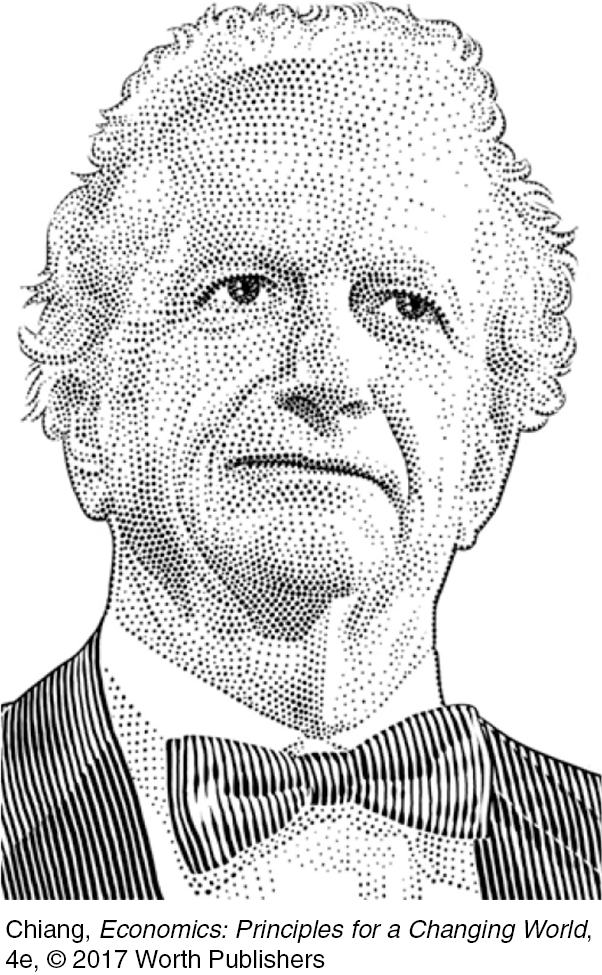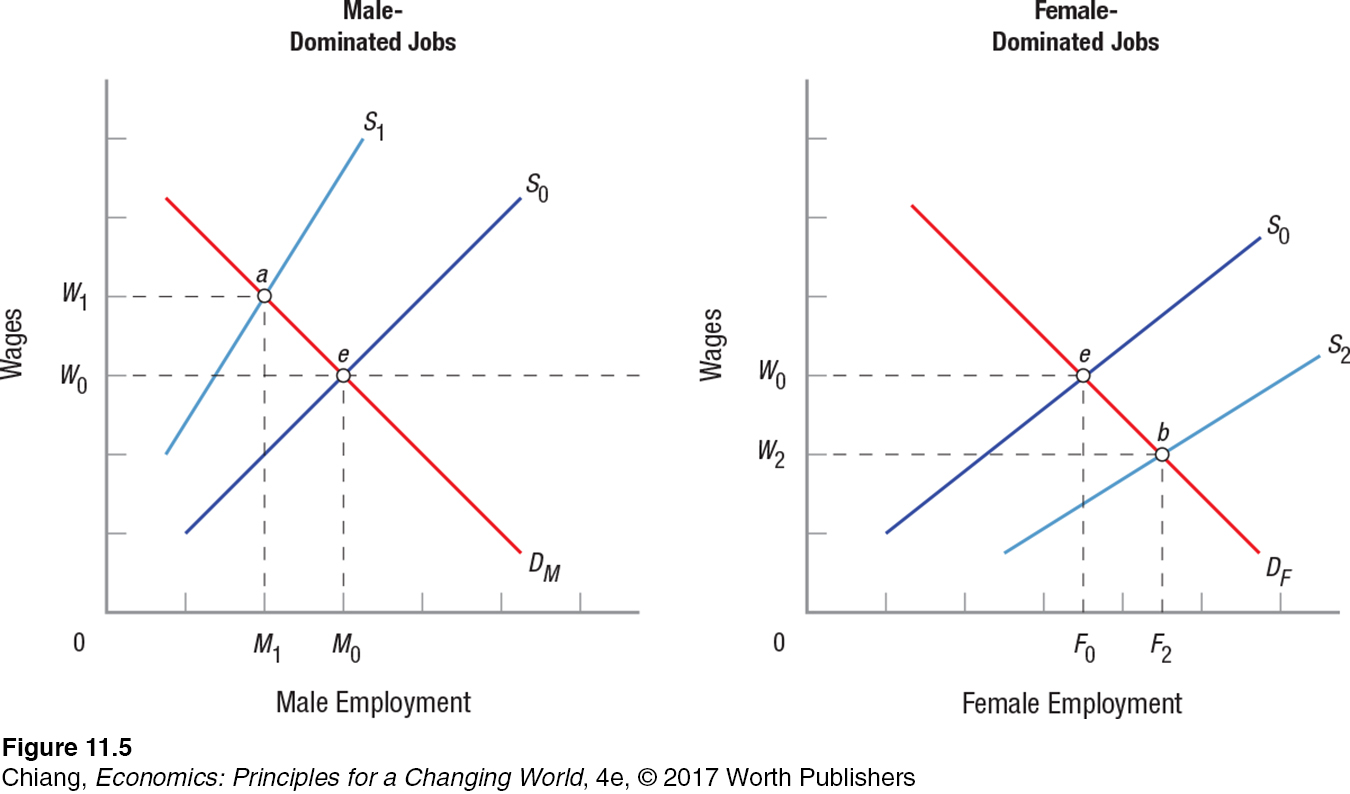ECONOMIC DISCRIMINATION
We have seen that all workers are paid the same wage in competitive labor markets. This is seen in real life in low-
economic discrimination When workers of equal ability are paid different wages or in any other way discriminated against because of race, color, religion, gender, age, national origin, sexual orientation, or disability.
Economic discrimination takes place whenever workers of equal ability and productivity are paid different wages or are otherwise discriminated against in the workplace because of their race, color, religion, gender, age, national origin, sexual orientation, or disability. This can mean that one group is paid lower wages than another for doing the same job, or that members of different groups are segregated into occupations that pay different wages.
The U.S. Bureau of Labor Statistics (BLS) measures wages for persons of various races and ethnicities as well as by gender in the labor force. Each year, it collects data on the gender wage gap, the salary that women make as a percentage of what men earn in the same occupation. The trend has represented a narrowing of the wage gap, indicating that gender discrimination has diminished over time. Less certain based on the data is whether discrimination based on race or ethnicity has seen similar improvements. Data from the BLS continue to show that African Americans and Latinos earn substantially less than Caucasians and Asians; however, these data are not separated by occupation. Thus, it is uncertain the extent to which these differences in earnings are due to discrimination as opposed to occupational choices.
Economic theories of discrimination generally take one of two approaches. The first, developed by Gary Becker, rests on the notion that bias is articulated in the discriminatory tastes of employers, workers, and consumers. The second approach, the segmented markets approach, maintains that labor markets are divided into segments based on race, gender, or some other category. This approach is often referred to as the job crowding hypothesis, or the dual labor market hypothesis.
Becker’s Theory of Economic Discrimination
Gary Becker’s main contribution to economics is that he vastly broadened the issues that economists study. This was no small feat. Before Becker’s influence, economists focused almost exclusively on the production and exchange of material goods and services. One early example shows the difficulties Becker faced in broadening this focus.
GARY BECKER (1930–2014)
NOBEL PRIZE

The 1992 winner of the Nobel Prize in Economic Sciences, Gary Becker, applied the theory of “rational choice” to areas of human behavior not ordinarily associated with economic analysis and research. He offered provocative insights on a broad array of subjects, including family relations, racial discrimination, and the criminal justice system.
Born in Pottsville, Pennsylvania, in 1930, Becker completed his undergraduate degree at Princeton before entering the University of Chicago, where he studied under economist Milton Friedman. In 1957 he published his dissertation The Economics of Discrimination, an analysis of the effects of racial prejudice on earnings and employment among minorities.
In 1981 he published his book A Treatise on the Family. According to his theory, rising wages led to changes in the family, including more women working outside the home instead of “specializing” in child care and housework. On questions of crime and punishment, Becker suggested that most criminals react in predictable ways to the costs and benefits of illegal activity; namely, that the probability of being caught and punished was a greater deterrent than the harsh nature of the punishment. On the question of race, Becker viewed discrimination as a “tax wedge” between social and private returns, concluding that prejudice tends to be economically detrimental to all parties concerned.
In 1955 Becker was asked to speak at Harvard about his dissertation on the economics of discrimination. Becker noted that his audience was perplexed. “They thought I would discuss price discrimination”—that is, the analysis of why businesses charge different prices for the same goods. “No one conceived that an economist would talk about race discrimination in those days.”2
2 Peter Passell, “New Nobel Laureate Takes Economics Far Afi eld,” The New York Times, October 14, 1992, p. D1.
Published in 1957, The Economics of Discrimination was not warmly received by the profession. Not until the mid-
Becker argued that employers who discriminate against women will lose market share and profit opportunities, both because they do not always hire the best employees available, and because they must pay mostly high-
In practice, we know that wage discrimination still exists. According to the Bureau of Labor Statistics, women in 2015 earned 82.5% of what men earned in the same occupation. Why might competition fail to erase wage differentials? For one thing, the adjustment costs of firing unproductive workers, giving them severance pay, then recruiting and training new workers can be extremely high, especially considering the protections unions and the legal system offer workers. Second, women may be less mobile than men when it comes to work. They may be less willing to move to accommodate employer preferences, and thus be forced to accept lower-
Segmented Labor Markets
segmented labor markets Labor markets split into separate parts. This leads to different wages paid to different sectors even though both markets are highly competitive.
Economists who advocate segmented labor market theories argue that discrimination does not arise due to a lack of competitive labor markets, but rather because these markets, although competitive, are segmented into a variety of constituent parts. And these different parts, while interacting, are noncompeting sectors. Segmented labor market theories have been developed along several different lines.
The dual labor market hypothesis splits the labor market into primary and secondary sectors. The primary market consists of jobs that offer high wages, good working conditions, job stability, and advancement opportunities, while jobs in the secondary market tend to have low wages and benefits, poor working conditions, high labor turnover, and little chance of advancement.
The job crowding hypothesis breaks occupations into predominately male and female jobs. In 1922 Edgeworth recognized this problem when he wrote, “The pressure of male trade unions appears to be largely responsible for that crowding of women into a comparatively few occupations, which is universally recognized as a main factor in the depression of their wages.”3
The insider−outsider theory maintains that workers are segregated into those who belong to unions and those who are unemployed or are nonunion workers. Alternatively, economists have recognized that large firms use internal promotion and job security to inspire loyalty to the firm; however, such practices can also become an indirect method of segregating the labor market.
3 F. Y. Edgeworth, “Equal Pay to Men and Women for Equal Work” (1922), p. 439, cited in Stephen Smith, Labour Economics (New York: Routledge), 1994, p. 102.
These hypotheses all predict that separate job markets will emerge for different groups. Figure 5 shows how segregated markets can lead to significant wage differentials, such as those we see for men and women.

In a world without discrimination, equilibrium wages for everyone would be W0, with total employment at M0 + F0. If some form of discrimination in male-
Notice that once such a wage differential is established, the firms in competitive markets have no real incentive to eliminate the gap. Men and women are both being paid their marginal revenue products; therefore, no profits are gained by substituting workers.
Wage differentials can arise for a variety of reasons. Some people may simply prefer one occupation to another. If such preferences have their roots in specific social groups, group-
Do wage differentials necessarily mean that discrimination exists in the market? Job crowding and wage differentials could just reflect different levels of human capital investment or different professional choices. Many women, for instance, may truly prefer occupations that are complementary to parenting. Further, female labor force participation is often interrupted when women take a break from working to have children. Therefore, jobs such as nursing, teaching, and administrative work may look attractive as women can leave their jobs, later returning or finding a new employer, with little loss in salary or benefits.

Public Policy to Combat Discrimination
For the first half of the last century, the inequities associated with various forms of discrimination were mostly accepted as a part of life in the United States. Gradually, however, a groundswell developed to end racial segregation and other forms of discrimination, culminating in passage of the Civil Rights Act in 1964. In what follows, we briefly outline the major acts and public policies that have been implemented with the goal of ending discrimination. Because of these policies, discrimination, wage differentials, and segmented labor markets have declined markedly over the past five decades.
The Equal Pay Act of 1963 The Equal Pay Act of 1963 amended the Fair Labor Standards Act of 1938. It requires that men and women receive equal pay for equal work. Equal work is defined as work performed under similar circumstances requiring equal effort, skill, and responsibility. Some argue that the Equal Pay Act was a hollow victory because occupational segregation forced women into specific occupations, causing them to earn less than men for essentially comparable work. Further, the law provided a limited time during which a worker must file a case against an employer for wage discrimination. This prevented many women from filing cases out of fear that they would lose their jobs.
In 2009 the Lily Ledbetter Fair Pay Act was signed into law, providing employees more flexibility to file cases asserting that they have been discriminated against with respect to pay. Specifically, it allowed the 180-
Civil Rights Act of 1964 Title VII of the Civil Rights Act of 1964 makes it unlawful to
refuse to hire or to discharge any individual, or otherwise to discriminate against any individual with respect to his [her] compensation, terms, conditions, or privileges of employment, because of such individual’s race, color, religion, sex, or national origin.
To date, most of the litigation brought under this statute has focused on the meaning of the phrase to discriminate, requiring a plaintiff to show that an employment practice inflicts a “disparate” or unequal impact on members of a minority group, as compared to its impact on others. Once this has been demonstrated, the burden shifts to the defendant (the employer) to show that its employment practices are related to employee performance or are otherwise a matter of “business necessity.” Plaintiffs may sue for a full range of remedies, including back pay, reinstatement, court costs, attorney’s fees, and punitive damages.
Executive Order 11246—
Affirmative action programs have been controversial from the outset. Critics see such programs as “enforced quotas,” whereas supporters see them as a way of breaking down discriminatory hiring barriers. Further, affirmative action has extended to other selection criteria such as college admissions.
In the summer of 2003, the U.S. Supreme Court ruled in the University of Michigan case (Gratz v. Bollinger) that adding a large specific numerical adjustment for minority group status to university admission criteria was unacceptable. The Law School at Michigan, on the other hand, simply took race into account in a nuanced approach to improving diversity of the class. The Supreme Court found this approach acceptable (Grutter v. Bollinger).
Age, Disabilities, and Sexual Orientation Two other acts were designed to reduce discrimination based on age and physical or mental disabilities. The Age Discrimination in Employment Act of 1967 protects workers over age 40 from discrimination based on age. The Americans with Disabilities Act of 1990 prohibits discrimination against people with a physical or mental disability who could still perform a job with reasonable accommodation by an employer. What constitutes “reasonable accommodation” has been a point of contention in many recent court cases. Lastly, the proposed Employment Non-
CHECKPOINT
ECONOMIC DISCRIMINATION
Economic discrimination occurs whenever workers of equal ability and productivity are paid different wages or otherwise discriminated against because of their race, color, religion, gender, age, national origin, sexual orientation, or disability.
Becker’s analysis of discrimination assumed that employers had a taste for discrimination, and he showed that both parties were harmed by discrimination.
Segmented labor markets assume that separate markets lead to wage differentials that represent discrimination.
Public policy to eliminate discrimination has included the Equal Pay Act of 1963, Civil Rights Act of 1964, Executive Order 11246 (Affirmative Action), Age Discrimination in Employment Act of 1967, Americans with Disabilities Act of 1990, and the Lily Ledbetter Fair Pay Act of 2009.
QUESTION: Some types of labor discrimination are more likely to be eroded by market forces than others. Provide an example of a type of discrimination that is likely to dissipate through the labor market and one that is likely to persist over time.
Answers to the Checkpoint questions can be found at the end of this chapter.
Discrimination in the workplace can be caused by preferences of employers, employees, or customers. If the discriminatory tastes are strictly due to employer preferences, then employers who discriminate will be forced to pay a higher wage for the “preferred” worker. Because employers who do not discriminate are able to hire an equally talented but less preferred worker at a lower wage, these employers will have a cost advantage in production. Over time, discriminating employers may need to reduce their discriminatory tastes or be forced out of business by lower-
If the discriminatory tastes lie with the employees or customers, however, firms may be less able to reduce labor discrimination. For example, if employees refuse to work with a certain type of worker, or if customers refuse to buy goods and services from a particular type of worker, hiring these workers may negatively affect the firm’s profit. Therefore, firms may choose to maintain segmented markets because the higher cost of labor is needed to prevent a potentially larger loss of revenues if their employees or customers act on their discriminatory tastes by refusing to work for or buy from the firm.